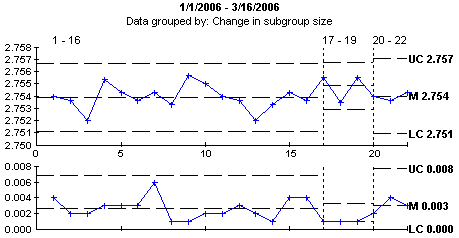Incomplete subgroups
If a data subgroup cannot be completed, you may enter the asterisk character ( * ) in place of the missing numeric value.
For example, you might normally weigh one sample from each of three fill heads and store the data with a subgroup size of three, such as:
|
Standard
|
Date/Time
|
Data 1
|
Data 2
|
Data 3
|
|
LIQUID GOO - WEIGHT CHECK
|
3/16/2006 13:04:22
|
2.752
|
2.756
|
2.753
|
However, at the next scheduled weight check, you find that fill head 2 is clogged, and so you only have data for the other two fill heads. You can enter this data as:
|
Standard
|
Date/Time
|
Data 1
|
Data 2
|
Data 3
|
|
LIQUID GOO - WEIGHT CHECK
|
3/16/2006 15:06:47
|
2.756
|
*
|
2.755
|
After resolving the problems with fill head 2, you can return to entering complete subgroups of three data values.
|
 Note: If your data entry session has been configured to perform calculations on the data values you enter, you may experience errors or incorrect data when you substitute the * character for a numeric data value. For more information, see Template Wizard Step 5 . Note: If your data entry session has been configured to perform calculations on the data values you enter, you may experience errors or incorrect data when you substitute the * character for a numeric data value. For more information, see Template Wizard Step 5 .
|
Incomplete subgroups on charts
Depending on your configuration settings for incomplete subgroups, the program may automatically group the data according to its effective subgroup size— the number of numeric data values in the subgroup.
When the number of numeric values in one subgroup is different from that of the previous subgroup, this newer subgroup becomes the first point in a new data group.

In the example above:
-
-
Data points 1-16 contain 3 numeric values per subgroup.
-
Data points 17-19 contain 2 numeric values (and one * ) per subgroup.
-
Data points 20 and beyond contain 3 numeric values per subgroup.
Incomplete subgroups on a data table
When incomplete subgroups are displayed on a data table, all data values— both numeric values and missing values— are shown.

In this example, data records with a subgroup size of 4 were all stored with a missing value for the 4th data point in the subgroup. Because missing values are always displayed on a data table, the Data4 column is displayed even though all values in this column are missing.
Real-time checks based on most recent data group
When data is grouped, real-time checks will be based on the control limits from the most recent group. This applies even if control limits are not displayed.
Because real-time control limits are calculated from the historical data in the new data group, you may need to enter the minimum number of subgroups needed to recalculate control limits or refresh the data before new control limits can be calculated and used for real-time checking on this new data group.
Incomplete subgroups or a different subgroup size?
-
Incomplete subgroups are intended only for infrequent use where a data value is missing. These missing values are always displayed on the data table.
-
If you are changing the number of values needed for a complete subgroup, you should use a different subgroup size to store data for this standard.
![]() Note: If your data entry session has been configured to perform calculations on the data values you enter, you may experience errors or incorrect data when you substitute the * character for a numeric data value. For more information, see Template Wizard Step 5 .
Note: If your data entry session has been configured to perform calculations on the data values you enter, you may experience errors or incorrect data when you substitute the * character for a numeric data value. For more information, see Template Wizard Step 5 .
